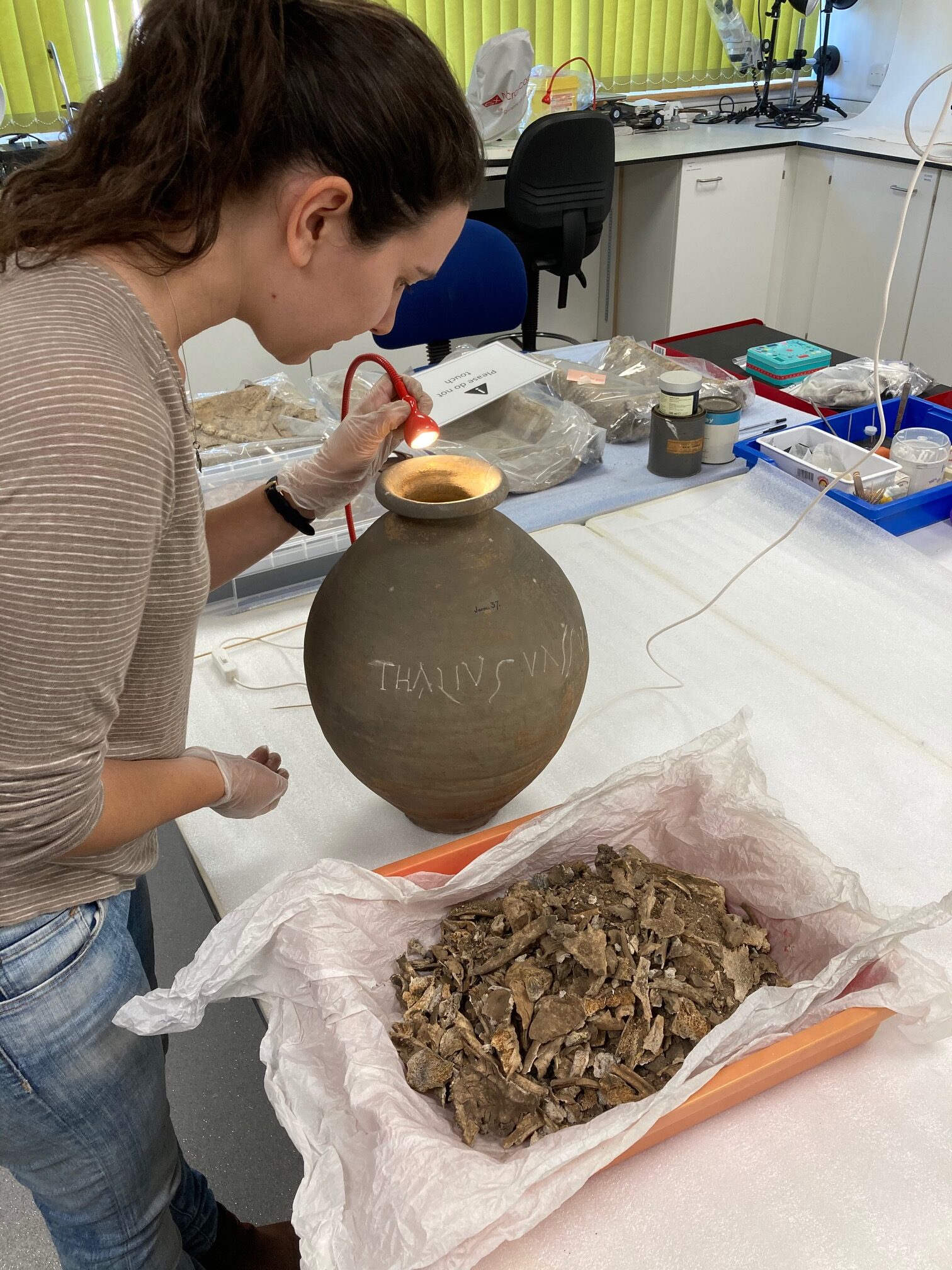
Supervisors
- Prof. Mary Lewis (University of Reading)
Email: m.e.lewis@reading.ac.uk - Dr Fiona Brock (Cranfield University)
Email: f.brock@cranfield.ac.uk - Glynn Davis (Colchester Museums)
Email: glynn.davis@colchester.gov.uk - Prof. Hella Eckardt (University of Reading)
Email: h.eckardt@reading.ac.uk
The team is made up of four experts with a long interest in Roman health (Prof Mary Lewis), Roman identities and mobility (Prof Hella Eckardt), Colchester’s heritage (Glynn Davis) and the scientific study of human remains (Dr Fiona Brock). Together they have extensive experience in supervising PhD students to completion and providing museum management training.
Subject
This project uses long neglected but nationally important cremated human remains held at Colchester Museums to explore identities during a time of major social transition. Colchester evolved from an important Iron Age centre to the first major military site and town in Roman Britain, offering an opportunity to explore how incoming and local people interacted during and after the Roman conquest. The student will work with museum specialists, bioarchaeologists and archaeological scientists to re-evaluate an understudied antiquarian collection of ca. 110 cremations to gain new insights into the impact of the Roman occupation of Britain, exploring issues around health, migration and burial practices.
Research questions and methods
The project seeks to address the following research questions:
- How did cremation practices change from the late Iron Age to the middle of the second century?
- What was life like for the people of Colchester and did it change during early Roman occupation?
- investigate trends in the age and sex of cremated individuals,
- consider the associated grave goods to explore status and identity,
- identify trends in trauma and pathology
- How can modern techniques advance our understanding of this important funerary practice?
- use macroscopic approaches to assess heat-induced alteration
- explore the use of potassium levels to identify the decomposition level of bodies at the time of burning
- use strontium stable isotopes to explore migration
The student will undertake a full osteological analysis of the museum material (biological sex, age, trauma, disease). A study of the Museum’s archives will allow these individuals to be reunited with their urns and grave goods to explore social status. Our understanding of this tradition will be transformed by strontium analysis of c.40 individuals, to provide information about the presence of non-locals (carried out by an external lab).
Fourier-transform infrared spectroscopy (FTIR) will be used for the first time on these remains to identify different cremation practices, and a spectrophotometer will be used to investigate the utility of bone colour to reconstruct burning temperature, the consistency of the burning, and maintenance of the pyre.
These new approaches will reveal valuable information about the individuals and the way they were cremated, details that were not obtainable when much of this material was first excavated and stored over one hundred years ago.
Research context
Despite being the dominant form of funerary practice in early Roman Britain, cremations continue to be understudied. With the development of new scientific approaches, our understanding of the practice itself has grown significantly but routine analysis of the bodies themselves is still rare, likely due to the specialist skills required in their analysis. Instead, academic studies of Roman funerary archaeology continue to focus on inhumations, obfuscating our understanding of life after the Roman conquest. This project will take advantage of new scientific techniques to explore the influence of Roman occupation on this funerary tradition in England’s first capital, Colchester.
Understanding the shifts and changes in this practice over time here, will serve as the basis for comparative studies; for example, ERC Lumiere study. The potential of this uniquely large sample (c. 110 cremations still unexamined) provides scope for the student to hone the project to address specific questions that interest them.
The successful candidate will write their own research proposal at the start of their project, using this proposal and an existing scoping document about comparative cremation sites as a basic framework. Whether they wish to concentrate on the biological profile and status of the individuals, pathologies in cremated remains or the experience of women and children, local or non-locals is open to the student. The student may be interested in museum and education aspects, and the challenges of using antiquarian collections to tell new stories.
Skills developed by student and employability enhancement
The successful candidate will likely have a Masters in human osteology, but will receive additional training in the analysis of cremations and sampling (Mary Lewis), theoretical approaches and Roman archaeology (Hella Eckardt), FTIR and spectrophotometry (Fiona Brock) and museum curation and collections management (Glynn Davis). Through this project the candidate will become one of a small number of cremation specialists in the UK, developing new methods for the examination and interpretation of cremated remains and using resources at Reading, Cranfield and the Museum.
The student will also make a significant contribution to our understanding of early Roman Britain. Thirdly, the student will develop important curatorial as well learning and engagement skills by being proactively involved in Colchester Museum’s curatorial work and public outputs. They will learn to present new knowledge through updated gallery displays and educational resources, contributing to Colchester Museums’ decolonisation programme, Hidden Histories, which seeks to broaden the stories and voices that present collections to the public.
The student will deliver a small display that contextualises cremations within this decolonising agenda and. develop online resources aimed at KS2 children exploring the people of Roman Britain. This work will diversify the representation of the people of Roman Britain. Secondly the student will be part of a working group reviewing and renewing the Museums’ current outdated policy concerning the curation of human remains. They will be expected to take the lead in presenting current academic thinking, aligning this with the Museums aspiration to present scientific approaches to the study of human remains in the permanent displays, especially at Colchester Castle.
Download project brief (Word, 31kB)
SWWDTP CDA application and assessment timeline, and application guidance.